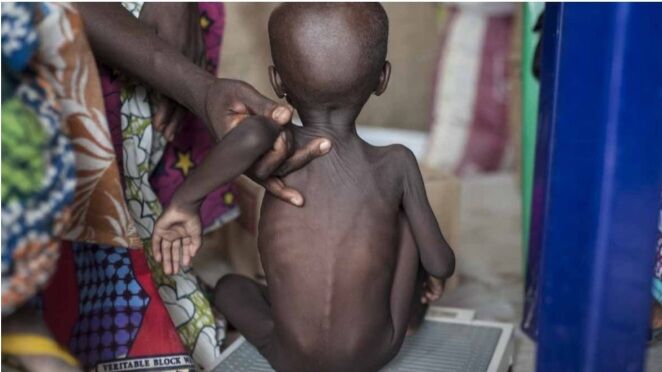By Ijeoma UKAZU
Rising costs of living, conflicts, climate shocks, and the ongoing impacts of COVID-19 are leaving an increasing number of children acutely malnourished, says five United Nation agencies.
These UN Agencies warn that prompt action should be taken to protect the most vulnerable children in 15 countries worst hit by the unprecedented food and nutrition crisis to avert any looming danger.
Achieving zero hunger, food security, and improving nutrition by 2030 requires consistent funding commitments by stakeholders and the global community, said the United Nations.
According to the World Health Organisation, WHO, report about 45 percent of deaths globally among children under five years of age are linked to undernutrition. These mostly occur in low- and middle-income countries.
“This is happening when key health nutrition and other life-saving services are becoming less accessible. Currently, more than 30 million children in the 15 worst-affected countries suffer from wasting or acute malnutrition, and eight million of these children are severely wasted, the deadliest form of under-nutrition.
“This is a major threat to children’s lives and to their long-term health and development, the impacts of which are felt by individuals, their communities, and their countries,” the UN said.
The five UN Agencies making this call include; The food and Agriculture Organisation, FAO, UN Refugee Agency, UNHCR, United Nations Children’s Fund, UNICEF, World Food Programme, WFP, and World Health Organisation, WHO.
These agencies in a statement called for accelerated progress on the Global Action Plan on Child Wasting. “This is aimed to prevent, detect and treat acute malnutrition among children in the worst-affected countries, which are Afghanistan, Burkina Faso, Chad, and the Democratic Republic of the Congo.
Others are Ethiopia, Haiti, Kenya, Madagascar, Mali, Niger, Nigeria, Somalia, South Sudan, Sudan, and Yemen. It said that the Global Action Plan addressed the need for a multi-sectoral approach and highlighted priority actions across maternal and child nutrition through the food, health, water and sanitation, and social protection systems.
According to the statement, in response to increasing needs, the UN agencies identified five priority actions that will be effective in addressing acute malnutrition in countries affected by conflict and natural disasters and in humanitarian emergencies.
It said scaling up these actions as a coordinated package will be critical for preventing and treating acute malnutrition in children, and averting a tragic loss of life.
“The UN agencies call for decisive and timely action to prevent this crisis from becoming a tragedy for the world’s most vulnerable children,” it said.
Director-General of the FAO, Mr. QU Dongyu, said that the situation would likely deteriorate even further in 2023.
“We must ensure availability, affordability, and accessibility of healthy diets for young children, girls, and pregnant and lactating women. “We need urgent action now to save lives, and to tackle the root causes of acute malnutrition, working together across all sectors,” Dongyu said.
The United Nations High Commissioner for Refugees, UNHCR, Filippo Grandi, said that the UN system was responding as one to the crisis, adding that UNHCR are working hard to improve analysis and targeting to ensure that they reach children who are most at risk, including internally-displaced and refugee populations.
The Executive Director of UNICEF, Catherine Russell, said cascading crises are leaving millions of children wasted and have made it harder for them to access key services.
The Executive Director of WFP, David Beasley, said more than 30 million children are acutely malnourished across the 15 worst-affected countries, so they must act now and must act together.
Beasley said it is critical that they collaborate to strengthen social safety nets and food assistance to ensure that Specialised Nutritious Foods are available to women and children who need them the most.
The Director-General of the WHO, Tedros Ghebreyesus, said that “the global food crisis is also a health crisis, and a vicious cycle, malnutrition leads to disease, and disease leads to malnutrition,”
He said urgent support is needed now in the hardest-hit countries to protect children’s lives and health, including ensuring critical access to healthy foods and nutrition services, especially for women and children.
In Nigeria, according to an October 2022 Cadre Harmonisé (CH) analysis conducted in 26 of Nigeria’s 36 states, including the Federal Capital Territory has shown that nearly 25 million Nigerians are at risk of facing hunger between June and August 2023 (lean season) if urgent action is not taken.
The government-led and UN-supported food and nutrition analysis is carried out twice a year, the data is a projected increase from the estimated 17 million people currently at risk of food insecurity.
The key drivers of this alarming trend remain the continued conflict, climate change, inflation, and rising food prices are on the rise with no signs of abating.
A Joint Statement from the Offices of the Food and Agriculture Organisation, FAO, the United Nations Office for the Coordination of Humanitarian Affairs, UN-OCHA, and the United Nations Children’s Fund, UNICEF, in Nigeria attributes the shortage of food to the persistent violence in the north-east states of Borno, Adamawa and Yobe, BAY, and armed banditry and kidnapping in states such as Katsina, Sokoto, Kaduna, Benue, and Niger.
“According to the National Emergency Management Agency, widespread flooding in the 2022 rainy season damaged more than 676,000 hectares of farmlands, which diminished harvests and increased the risk of food insecurity for families across the country.
“Flooding is one of the effects of climate change and variability impacting Nigeria. More extreme weather patterns affecting food security are anticipated in the future,” the statement reads.
It further reveals that of the 17 million people who are currently food insecure, 3 million are in the north-east BAY states and the possibility of an increase cannot be ruled out.
“Without immediate action, this figure is expected to increase to 4.4 million in the lean season. This includes highly vulnerable displaced populations and returnees who are already struggling to survive a large-scale humanitarian crisis in which 8.3 million people need assistance.
“The food security and nutrition situation across Nigeria is deeply concerning,” said Mr. Matthias Schmale, the Resident and Humanitarian Coordinator for Nigeria. “I have visited nutrition stabilization centers filled with children who are fighting to stay alive. We must act now to ensure they and others get the lifesaving support they need.”
The report also states that children are the most vulnerable to food insecurity. Approximately 6 of the 17 million food-insecure Nigerians today are children under 5 living in Borno, Adamawa, Yobe, Sokoto, Katsina, and Zamfara states.
There is a serious risk of mortality among children attributed to acute malnutrition. In the BAY states alone, the number of children suffering from acute malnutrition is expected to increase from 1.74 million in 2022 to 2 million in 2023.
UNICEF, working with government and partners such as Médecins Sans Frontières, MSF, and Alliance for International Medical Action, ALIMA, is investing in scaling up preventive nutrition interventions, while ensuring that vulnerable children have access to life-saving nutrition services. In 2022, UNICEF with its partners was able to reach approximately 650,000 children with life-saving nutrition services across the six states mentioned above.
Stock photo: A malnourished child



